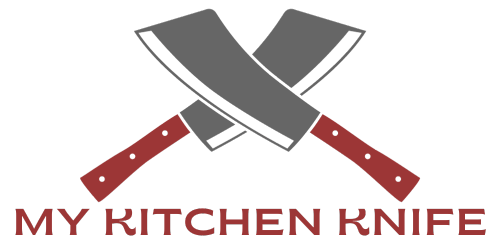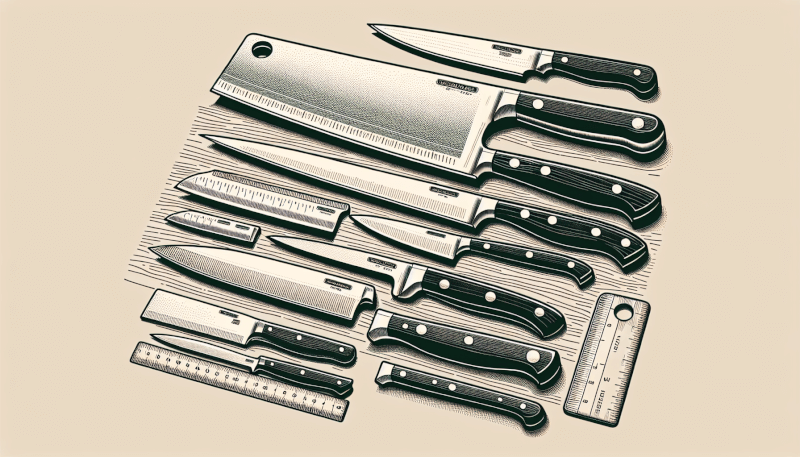Looking to upgrade your kitchen knife collection? Look no further! This article highlights the top picks for the best kitchen knives specifically designed for chopping. Whether you’re slicing up vegetables or deboning a chicken, these knives have been proven to provide outstanding performance and precision. Get ready to take your chopping skills to the next level with these top-notch kitchen knives.
1. Overview
1.1 Importance of a Good Chopping Knife
When it comes to preparing meals in the kitchen, having a good chopping knife is essential. Whether you’re chopping vegetables, slicing meat, or dicing herbs, the right knife can make all the difference in your culinary experience. A well-designed chopping knife not only provides precision and control but also ensures your safety while handling sharp objects. It allows you to chop ingredients with ease and efficiency, saving you time and effort in the kitchen.
1.2 Factors to Consider when Choosing a Chopping Knife
Choosing the best chopping knife for your needs can be overwhelming with the wide array of options available in the market. However, considering a few key factors can help you make an informed decision. Firstly, the blade material is crucial. High-carbon stainless steel is a popular choice due to its durability, sharpness, and resistance to rust. Additionally, the blade should have a full tang, which means it extends through the handle, providing stability and balance.
Another important factor is the size and weight of the knife. Different individuals have different preferences, so it’s essential to choose a knife that feels comfortable in your hand. A heavier knife may provide more power for chopping, while a lighter knife may provide more agility for intricate tasks. Lastly, consider the handle material and design. A comfortable and ergonomic handle ensures a secure grip and reduces strain on your hand during extended chopping sessions.
1.3 Different Types of Chopping Knives
There are several types of chopping knives available, each designed for specific tasks and cutting styles. Let’s explore some of the most popular ones:
Chef’s Knife: This versatile knife is a must-have in any kitchen. With a broad and curved blade, it excels in chopping, dicing, and slicing ingredients of all sizes.
Santoku Knife: Originating from Japan, the Santoku knife is ideal for precision slicing, dicing, and mincing. It features a shorter and wider blade compared to a traditional chef’s knife, making it suitable for individuals with smaller hands.
Cleaver: The cleaver is known for its heavy and thick blade. It is perfect for handling tough tasks such as splitting bone or crushing garlic cloves. It’s also commonly used for tenderizing meat.
Nakiri Knife: This Japanese knife is specifically designed for chopping vegetables. With its straight, thin blade, it allows for precise cuts and reduces the risk of crushing delicate produce.
Chinese Chef’s Knife: Similar to a traditional chef’s knife, the Chinese chef’s knife differs in its rectangular-shaped blade and wider surface area. It is excellent for chopping and slicing large quantities of ingredients.
Japanese Vegetable Knife: Also known as a “usuba” knife, it is exclusively crafted for vegetable preparation. Its thin and flat blade enables precise cutting without tearing or bruising the produce.
Paring Knife: This small-sized knife is perfect for intricate tasks such as peeling, trimming, and shaping ingredients. Its short blade provides excellent control and maneuverability.
Bread Knife: Specifically designed for slicing bread and cake, this knife features a serrated edge that effortlessly cuts through crusty or delicate surfaces without causing damage.
Serrated Utility Knife: This versatile knife combines the serrated edge of a bread knife with the maneuverability of a utility knife. It is suitable for slicing tomatoes, fruits, and small bread rolls.
1.4 Price Range and Budget
When it comes to kitchen knives, the price range can vary significantly depending on factors such as brand, materials used, and craftsmanship. While it’s tempting to splurge on a high-end knife, it’s important to find a balance between quality and budget. Thankfully, there are excellent chopping knives available at various price points to suit every pocket. It’s worth investing in a good-quality knife that will last for years to come and elevate your cooking experience.
2. Chef’s Knife
2.1 Description and Features
The chef’s knife is considered the workhorse in the kitchen due to its versatility and functionality. It typically features a blade length between 8 and 10 inches and a broad, curved shape. The blade material is often high-carbon stainless steel, ensuring durability and resistance to corrosion. The full tang construction provides stability and balance, allowing for precise and controlled chopping. The handle can be made from various materials, including wood, stainless steel, or composite materials like G-10.
2.2 Pros and Cons
One of the main advantages of a chef’s knife is its versatility. From slicing tomatoes to dicing onions, this knife can handle a wide range of ingredients and cutting techniques. Its curved blade allows for rocking motions, making it efficient for chopping herbs and mincing garlic. However, due to its larger size, it may not be the best choice for people with smaller hands or individuals who prefer more agility and control during chopping tasks.
2.3 Best Chef’s Knives for Chopping
[Brand A] Chef’s Knife: With its high-quality stainless steel blade, ergonomic handle, and excellent balance, this chef’s knife is a favorite among professional chefs and home cooks alike. Its sharpness and durability make it perfect for chopping a variety of ingredients.
[Brand B] Chef’s Knife: This chef’s knife features a unique blade design that enhances food release, allowing for even and precise chopping. The comfortable handle provides a secure grip, minimizing hand fatigue during prolonged chopping sessions.
[Brand C] Chef’s Knife: Crafted with a Damascus steel blade, this chef’s knife offers exceptional sharpness and edge retention. Its ergonomic handle ensures comfort and control, making it an excellent choice for chopping tasks.
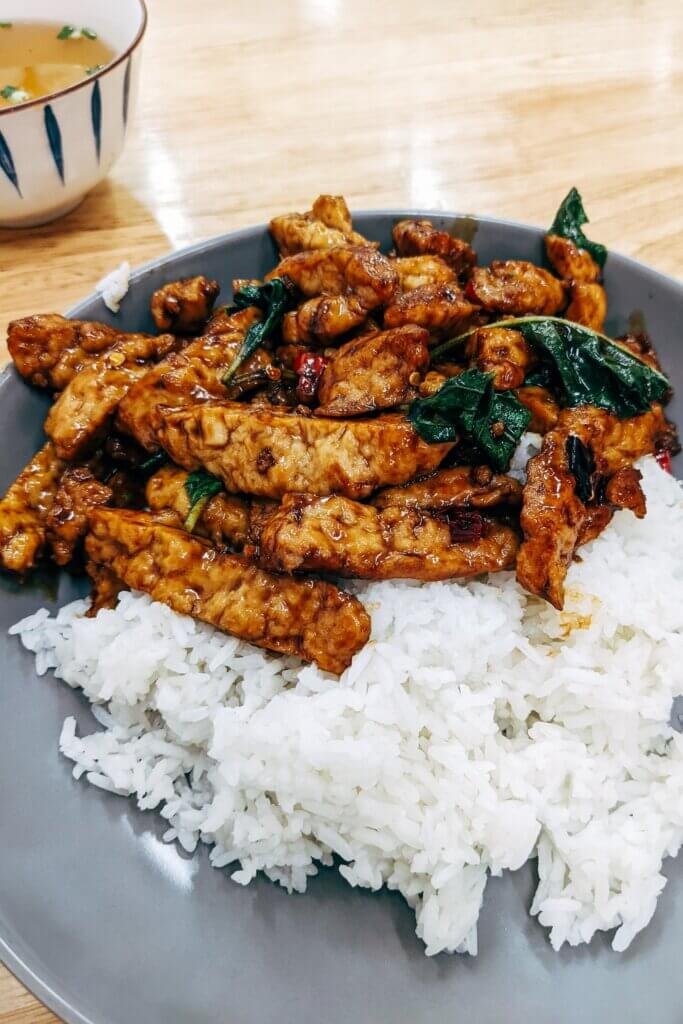
3. Santoku Knife
3.1 Description and Features
The Santoku knife originated in Japan and has gained popularity worldwide due to its versatility and precision. It typically has a shorter blade compared to a chef’s knife, ranging between 5 and 7 inches. The blade is wider, enabling efficient chopping without the need for a rocking motion. Similar to a chef’s knife, the Santoku blade is often made from high-carbon stainless steel for durability and sharpness. The handle can be made from various materials, providing comfort and control.
3.2 Pros and Cons
The Santoku knife offers several advantages for chopping tasks. Its shorter and wider blade allows for better control, especially for individuals with smaller hands. The flat cutting edge ensures clean and precise cuts, particularly when slicing thin ingredients. However, due to its shorter length, it may not be the best option for chopping larger or tougher ingredients compared to a chef’s knife.
3.3 Best Santoku Knives for Chopping
[Brand A] Santoku Knife: This Santoku knife is constructed with a high-quality stainless steel blade that retains sharpness even after extended use. The ergonomic handle provides a comfortable grip, making it suitable for prolonged chopping tasks.
[Brand B] Santoku Knife: Crafted with precision and attention to detail, this Santoku knife features a Damascus steel blade that offers superior cutting performance. The balanced weight distribution ensures stability and control while chopping.
[Brand C] Santoku Knife: With its razor-sharp blade and ergonomic handle, this Santoku knife is a favorite among professional chefs and home cooks alike. The dimpled blade design prevents food from sticking, allowing for effortless chopping and slicing.
4. Cleaver
4.1 Description and Features
The cleaver is a heavy-duty chopping knife designed for tough tasks in the kitchen. It features a thick and heavy blade, ranging between 6 and 8 inches, and a sturdy handle for stability and control. The blade is typically made from high-carbon stainless steel, ensuring durability and resistance to corrosion. The edge of the cleaver is angled, allowing for forceful chopping, crushing, and splitting. The handle can be made from various materials, providing a comfortable grip.
4.2 Pros and Cons
The cleaver excels in tasks that require strength and precision. Its heavy blade can easily break down large cuts of meat, chop bone, or crush garlic cloves. The flat surface can be used for transferring ingredients from the cutting board to the pan. However, due to its weight and size, it may not be suitable for intricate or delicate tasks that require more agility.
4.3 Best Cleavers for Chopping
[Brand A] Cleaver: This cleaver features a high-quality stainless steel blade that provides excellent strength and durability. The comfortable handle ensures a secure grip, allowing for controlled and precise chopping.
[Brand B] Cleaver: Crafted with superior craftsmanship, this cleaver offers exceptional chopping performance. Its sharp blade and balanced weight distribution make it ideal for both professional chefs and home cooks.
[Brand C] Cleaver: This cleaver is designed with a high-carbon stainless steel blade that resists rust and maintains sharpness. The ergonomic handle reduces fatigue during extended chopping sessions, making it a reliable choice for any kitchen.
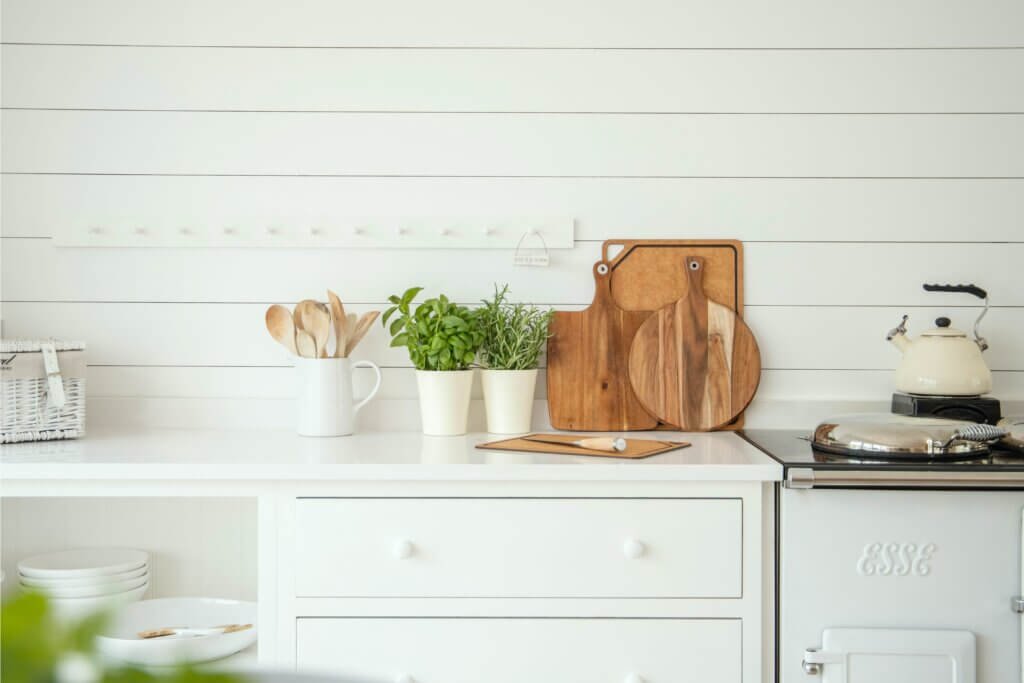
5. Nakiri Knife
5.1 Description and Features
The Nakiri knife is a Japanese knife specifically designed for chopping vegetables. It features a straight and thin blade, typically ranging between 6 and 7 inches. The blade is made from high-carbon stainless steel, ensuring sharpness and durability. The flat edge allows for precise and clean cuts, minimizing damage to delicate produce. The handle can be made from various materials, providing comfort and control while chopping.
5.2 Pros and Cons
The Nakiri knife offers several advantages for vegetable chopping tasks. Its thin blade reduces the risk of crushing or bruising delicate produce such as herbs or leafy greens. The flat cutting edge allows for efficient chopping and slicing. However, due to its specialized design, it may not be the best choice for handling tasks that involve meat or other ingredients.
5.3 Best Nakiri Knives for Chopping
[Brand A] Nakiri Knife: This Nakiri knife features a high-quality stainless steel blade that retains sharpness for a long time. The ergonomic handle ensures comfort and control, making it perfect for precise vegetable chopping.
[Brand B] Nakiri Knife: Crafted with attention to detail, this Nakiri knife offers exceptional cutting performance. The thin and flat blade design allows for effortless chopping and slicing of vegetables.
[Brand C] Nakiri Knife: With its razor-sharp blade and comfortable handle, this Nakiri knife is a favorite among both professional chefs and home cooks. Its precise cutting ability makes it an excellent choice for vegetable-focused dishes.
6. Chinese Chef’s Knife
6.1 Description and Features
The Chinese chef’s knife, also known as a Cai Dao or Vegetable Cleaver, shares similarities with a traditional chef’s knife but differs in its rectangular-shaped blade. It typically has a wider surface area, ranging between 7 and 9 inches. The blade is made from high-carbon stainless steel, ensuring durability and sharpness. The full tang construction provides stability and balance, allowing for precise chopping. The handle can be made from various materials, providing comfort and control.
6.2 Pros and Cons
The Chinese chef’s knife offers a unique chopping experience. Its rectangular-shaped blade provides a wide surface area, making it efficient for chopping and slicing large quantities of ingredients. The curved edge allows for rocking motions, ideal for finely chopping herbs or garlic. However, its larger size and weight may not be suitable for individuals with smaller hands or those who prefer more agility and control.
6.3 Best Chinese Chef’s Knives for Chopping
[Brand A] Chinese Chef’s Knife: This Chinese chef’s knife is crafted with precision and attention to detail. Its high-carbon stainless steel blade offers excellent performance, while the ergonomic handle ensures a comfortable grip during chopping sessions.
[Brand B] Chinese Chef’s Knife: With its exceptional balance and sharpness, this Chinese chef’s knife provides effortless chopping and slicing. The full tang blade construction guarantees stability and control for prolonged chopping tasks.
[Brand C] Chinese Chef’s Knife: This Chinese chef’s knife features a high-quality stainless steel blade that resists rust and retains sharpness. The comfortable handle offers a secure grip, making it a reliable choice for any chopping needs.

7. Japanese Vegetable Knife
7.1 Description and Features
The Japanese vegetable knife, also known as a “usuba” knife, is exclusively crafted for vegetable preparation. It typically features a thin and flat blade, ranging between 6 and 7 inches. The blade is made from high-carbon stainless steel, providing sharpness and durability. The flat edge ensures clean and precise cuts, minimizing damage to delicate produce. The handle can be made from various materials, offering comfort and control while chopping.
7.2 Pros and Cons
The Japanese vegetable knife excels in precision vegetable chopping tasks. Its thin blade allows for precise cuts without tearing or bruising delicate produce. The flat cutting edge ensures clean and even slices, enhancing the presentation of dishes. However, its specialized design may not be suitable for handling tasks that involve meat or other ingredients.
7.3 Best Japanese Vegetable Knives for Chopping
[Brand A] Japanese Vegetable Knife: This Japanese vegetable knife is crafted with traditional techniques and expertise. Its high-carbon stainless steel blade provides superior cutting performance, while the ergonomic handle ensures comfort and control.
[Brand B] Japanese Vegetable Knife: With its razor-sharp blade and lightweight design, this Japanese vegetable knife offers effortless chopping and slicing. The thin blade allows for precise cuts, ensuring the integrity of the delicate produce.
[Brand C] Japanese Vegetable Knife: This Japanese vegetable knife features a high-quality stainless steel blade that retains sharpness and resists corrosion. The comfortable handle provides a secure grip, making it ideal for any vegetable chopping task.
8. Paring Knife
8.1 Description and Features
The paring knife is a small-sized knife designed for intricate tasks such as peeling, trimming, and shaping ingredients. It typically features a blade length of 3 to 4 inches, providing excellent control and maneuverability. The blade is made from high-carbon stainless steel, ensuring sharpness and durability. The handle can be made from various materials, offering comfort and control while handling.
8.2 Pros and Cons
The paring knife offers several advantages for precise chopping tasks. Its small size allows for intricate cuts and detailed work. The sharp blade ensures clean and controlled slicing, making it ideal for tasks such as peeling fruits or deveining shrimp. However, due to its small size, it may not be suitable for tasks that require chopping larger quantities of ingredients.
8.3 Best Paring Knives for Chopping
[Brand A] Paring Knife: This paring knife features a high-quality stainless steel blade that provides excellent sharpness and edge retention. The comfortable handle ensures a secure and comfortable grip, making it perfect for precise chopping tasks.
[Brand B] Paring Knife: Crafted with precision, this paring knife offers exceptional cutting performance. Its small size and razor-sharp blade make it ideal for intricate and delicate chopping tasks.
[Brand C] Paring Knife: With its durable blade and ergonomic handle, this paring knife is a reliable choice for any kitchen. Its versatility allows for various chopping techniques, from peeling to trimming.
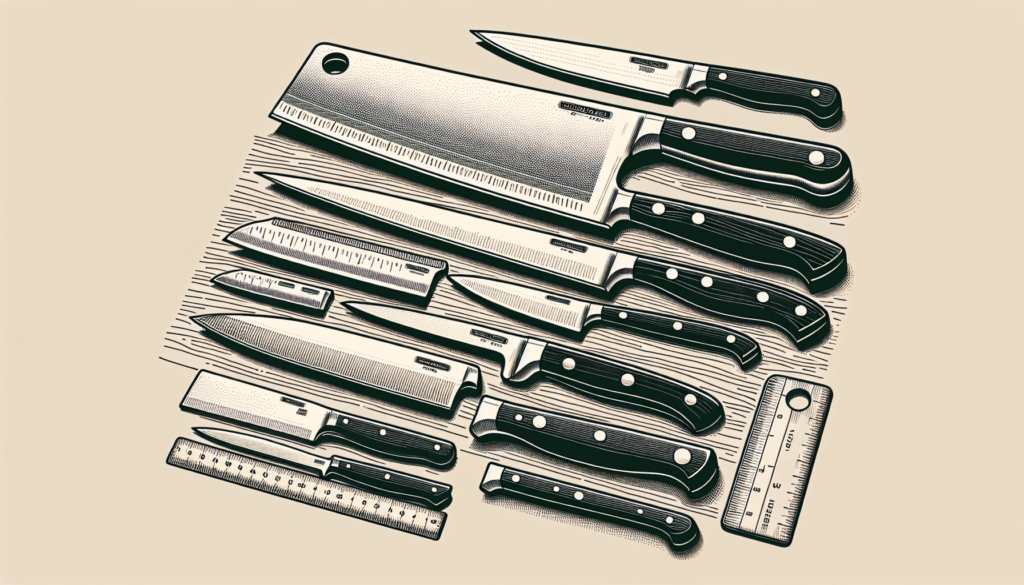
10. Serrated Utility Knife
10.1 Description and Features
The serrated utility knife is a versatile knife that combines the serrated edge of a bread knife with the maneuverability of a utility knife. It typically features a blade length between 4 and 6 inches. The blade is made from high-carbon stainless steel, ensuring durability and sharpness. The serrated edge allows for effortless slicing through foods with a hard exterior and soft interior, such as tomatoes or bread. The handle can be made from various materials, offering comfort and control.
10.2 Pros and Cons
The serrated utility knife offers the best of both worlds, combining the slicing ability of a serrated knife with the precision of a utility knife. Its serrated edge allows for effortless cutting through tough exteriors without crushing the delicate interior. However, due to its specific functionality, it may not be the best choice for tasks that require precise chopping or slicing.
10.3 Best Serrated Utility Knives for Chopping
[Brand A] Serrated Utility Knife: This serrated utility knife features a high-quality stainless steel blade that retains sharpness and resists rust. The ergonomic handle provides a comfortable grip, making it suitable for a variety of chopping tasks.
[Brand B] Serrated Utility Knife: Crafted with attention to detail, this serrated utility knife offers exceptional cutting performance. Its serrated edge effortlessly slices through various foods, ensuring clean and precise cuts.
[Brand C] Serrated Utility Knife: This serrated utility knife is designed with a durable blade and ergonomic handle. Its versatility makes it a reliable choice for any chopping needs, from slicing bread to cutting through tough-skinned fruits and vegetables.
In conclusion, having the right kitchen knife for chopping is crucial for efficient and enjoyable cooking experiences. Whether you choose a versatile chef’s knife, a precise Nakiri knife, or a specialized vegetable knife, each type offers unique features that cater to specific chopping tasks. Consider the factors discussed, such as blade material, size, weight, and handle design when choosing your chopping knife. Remember, investing in a good-quality knife will not only enhance your chopping skills but also make your time in the kitchen more enjoyable. Happy chopping!
